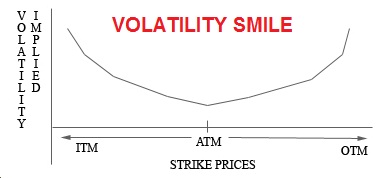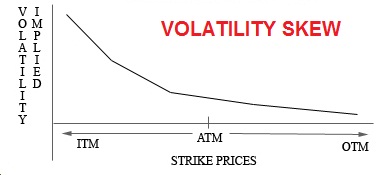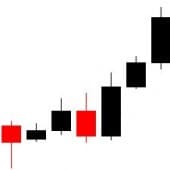Regular readers will by now be familiar with the fact that one of the most popular options valuation models out there is the Black-Scholes model.
Black-Scholes uses a number of inputs to calculate a fair market value for a European-style option. One of these inputs is the volatility.
Modern traders, however, often use Black-Scholes in a different way: they already have the price of the option, which is the price quoted by the market maker. They therefore use this price to reverse calculate the implied volatility of the options.
Volatility discrepancies: the volatility smile
If one follows that approach, it seems logical that options with the same expiration date, but different state of ‘moneyness’ would have the same volatility. i.e. ITM, ATM and OTM options for the same expiration date would have the same implied volatility.
In real life this is seldom the case. A well-known example is that of the so-called volatility smile. The principle is illustrated below in Fig. 9.26(e)
What becomes immediately clear is that the chart is not flat, as one would normally expect. Instead implied volatilities for ITM and OTM options are markedly higher than that of ATM options.
What can a trader deduce from this? An option with a volatility smile simply tells the trader that demand for ITM and OTM options are higher than demand for ATM options. This happens very often with near-term stock options and it is also a common phenomenon in the world of forex options.
A volatility smile also usually appears when a stock or currency is particularly volatile, i.e. the possibility of rapid price movements has already been discounted in the price of ITM and OTM options. Everything else being equal, this could present an opportunity for traders who could exploit the situation with volatility strategies such as the long straddle.
The volatility skew
With the volatility skew traders have a different scenario. Here also there is no straight line depicting volatilities for a given expiration date, but in this case it’s only ITM options that exhibit higher volatilities. 
In this case volatilities for ATM and OTM options, although not forming a straight line, are closer to the values predicted by the Black Sholes model. An increase in demand for ITM options, however, results in higher than expected volatilities for these options.
Volatility crunch
More beginner traders have probably lost money through the unexpected workings of the volatility crunch than through any other phenomenon in the world of options trading.
The volatility crunch usually strikes just after a major announcement from a company, e.g. an earnings report. Assume e.g. company ABC is expected to announce sterling profits in a few days’ time. The price of call options starts to increase dramatically and on the basis of that trader John decides to buy a few contracts of ABC calls.
After the profit announcement the price of Company ABC shares indeed rocket by perhaps 10% – but when trader John opens his options trading account, he finds to his dismay that the price of his call options had in fact started to drop.
This is the volatility crunch in action. Experienced options traders started buying ABC call options much longer before the time than trader John. When the earnings announcement was finally made, these astute traders had already started selling their call options again. Suddenly there were no buyers for ABC call options; implied volatility collapsed and the price of these options started to plummet.
Original post
- English (UK)
- English (India)
- English (Canada)
- English (Australia)
- English (South Africa)
- English (Philippines)
- English (Nigeria)
- Deutsch
- Español (España)
- Español (México)
- Français
- Italiano
- Nederlands
- Português (Portugal)
- Polski
- Português (Brasil)
- Русский
- Türkçe
- العربية
- Ελληνικά
- Svenska
- Suomi
- עברית
- 日本語
- 한국어
- 简体中文
- 繁體中文
- Bahasa Indonesia
- Bahasa Melayu
- ไทย
- Tiếng Việt
- हिंदी
More About Volatility Skews, Crunches And Smiles
Published 03/15/2013, 03:59 AM
Updated 07/09/2023, 06:31 AM
More About Volatility Skews, Crunches And Smiles
Latest comments
Loading next article…
Install Our App
Risk Disclosure: Trading in financial instruments and/or cryptocurrencies involves high risks including the risk of losing some, or all, of your investment amount, and may not be suitable for all investors. Prices of cryptocurrencies are extremely volatile and may be affected by external factors such as financial, regulatory or political events. Trading on margin increases the financial risks.
Before deciding to trade in financial instrument or cryptocurrencies you should be fully informed of the risks and costs associated with trading the financial markets, carefully consider your investment objectives, level of experience, and risk appetite, and seek professional advice where needed.
Fusion Media would like to remind you that the data contained in this website is not necessarily real-time nor accurate. The data and prices on the website are not necessarily provided by any market or exchange, but may be provided by market makers, and so prices may not be accurate and may differ from the actual price at any given market, meaning prices are indicative and not appropriate for trading purposes. Fusion Media and any provider of the data contained in this website will not accept liability for any loss or damage as a result of your trading, or your reliance on the information contained within this website.
It is prohibited to use, store, reproduce, display, modify, transmit or distribute the data contained in this website without the explicit prior written permission of Fusion Media and/or the data provider. All intellectual property rights are reserved by the providers and/or the exchange providing the data contained in this website.
Fusion Media may be compensated by the advertisers that appear on the website, based on your interaction with the advertisements or advertisers.
Before deciding to trade in financial instrument or cryptocurrencies you should be fully informed of the risks and costs associated with trading the financial markets, carefully consider your investment objectives, level of experience, and risk appetite, and seek professional advice where needed.
Fusion Media would like to remind you that the data contained in this website is not necessarily real-time nor accurate. The data and prices on the website are not necessarily provided by any market or exchange, but may be provided by market makers, and so prices may not be accurate and may differ from the actual price at any given market, meaning prices are indicative and not appropriate for trading purposes. Fusion Media and any provider of the data contained in this website will not accept liability for any loss or damage as a result of your trading, or your reliance on the information contained within this website.
It is prohibited to use, store, reproduce, display, modify, transmit or distribute the data contained in this website without the explicit prior written permission of Fusion Media and/or the data provider. All intellectual property rights are reserved by the providers and/or the exchange providing the data contained in this website.
Fusion Media may be compensated by the advertisers that appear on the website, based on your interaction with the advertisements or advertisers.
© 2007-2024 - Fusion Media Limited. All Rights Reserved.
